-
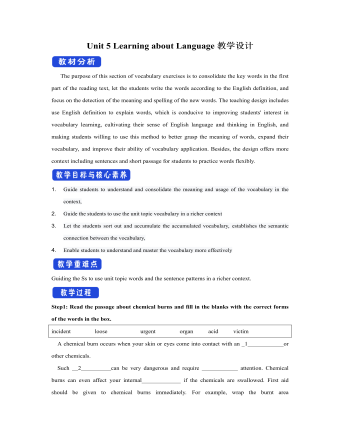
新人教版高中英语选修2Unit 5 Learning about Language教学设计
The purpose of this section of vocabulary exercises is to consolidate the key words in the first part of the reading text, let the students write the words according to the English definition, and focus on the detection of the meaning and spelling of the new words. The teaching design includes use English definition to explain words, which is conducive to improving students' interest in vocabulary learning, cultivating their sense of English language and thinking in English, and making students willing to use this method to better grasp the meaning of words, expand their vocabulary, and improve their ability of vocabulary application. Besides, the design offers more context including sentences and short passage for students to practice words flexibly.1. Guide students to understand and consolidate the meaning and usage of the vocabulary in the context, 2. Guide the students to use the unit topic vocabulary in a richer context3. Let the students sort out and accumulate the accumulated vocabulary, establishes the semantic connection between the vocabulary,4. Enable students to understand and master the vocabulary more effectivelyGuiding the Ss to use unit topic words and the sentence patterns in a richer context.Step1: Read the passage about chemical burns and fill in the blanks with the correct forms of the words in the box.
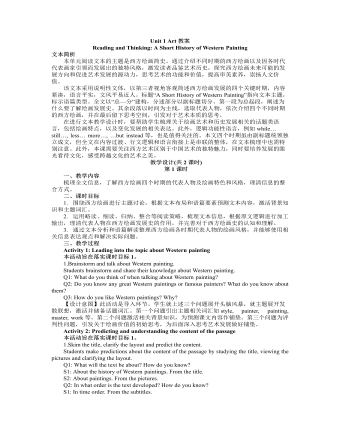
新人教版高中英语选修3Unit 1 Art教案
[2] An important breakthrough…was… [3] Another innovation was … [4] the emphasis increasingly shifted from…to… [5] New ideas and values gradually replaced… [6] While his paintings still had religious themes… … T: All these expressions serve to show how Western painting has developed. Some of them share similar structure but with varied use of words, which makes the text vivid and more readable. 【设计意图】主题类语言整理有助于学生类化语言应用,提高语言输出的丰富性。处理完文本内容信息后,进入语篇信息处理,进行主题相关的词块归类。引导学生快速阅读,寻找表达相同主题(发展或者艺术)的词和短语,再根据词性、用法和结构进行归类,储备主题相关词汇,丰富语言储备,提升语言素养。 Assignment: Go online to gather more information about Chinese painting and write a short history of it. 【设计意图】结合所学,迁移运用,根据实际语境,进行模仿性运用。在此过程中,学生尝试借鉴已学的语言、内容、语篇结构和写作手法来建构新文本,实现语篇输出,同时关注中西艺术文化的差别,加深对优秀文化的认同,培养文化意识。
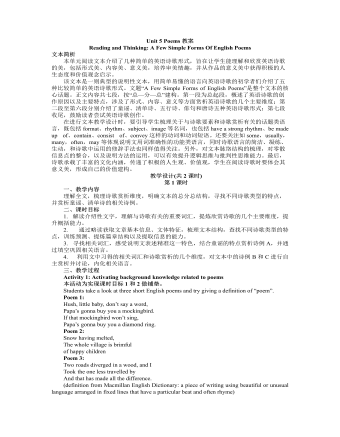
新人教版高中英语选修3Unit 5 Poems教案
本单元阅读文本介绍了几种简单的英语诗歌形式,旨在让学生能理解和欣赏英语诗歌的美,包括形式美、内容美、意义美,培养审美情趣,并从作品的意义美中获得积极的人生态度和价值观念启示。 该文本是一则典型的说明性文本,用简单易懂的语言向英语诗歌的初学者们介绍了五种比较简单的英语诗歌形式。文题“A Few Simple Forms of English Poems”是整个文本的核心话题。正文内容共七段,按“总—分—总”建构。第一段为总起段,概述了英语诗歌的创作原因以及主要特点,涉及了形式、内容、意义等方面赏析英语诗歌的几个主要维度;第二段至第六段分别介绍了童谣、清单诗、五行诗、俳句和唐诗五种英语诗歌形式;第七段收尾,鼓励读者尝试英语诗歌创作。 在进行文本教学设计时,要引导学生梳理关于与诗歌要素和诗歌赏析有关的话题类语言,既包括format、rhythm、subject、image等名词,也包括have a strong rhythm、be made up of、contain、consist of、convey这样的动词和动词短语。
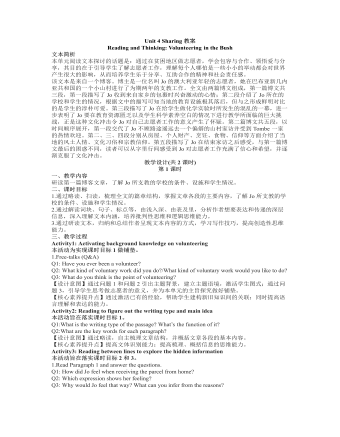
新人教版高中英语选修4Unit 4 Sharing教案
【核心素养提升点】学会将抽象信息进行可视化表达,提高信息处理能力和分析、推理等高阶思维品质;在跨文化交际中学会以国际视野接受和包容不同的文化。 5.Read Paragraph 2, draw a mind map and answer the questions. Q1:What did Jo learn about Tombe’s life? Q2:What kind of life do the natives lead? Read paragraph 2-5 and draw a mind-map. (Focus on accommodation, possession, diet and belief) 【设计意图】引导学生利用思维导图和问题链等形式来厘清当地人的生活方式,更好地处理和归纳信息 【核心素养提升点】提高信息处理能力、分析和归纳能力,包容异国文化、扩展国际视野。 6.Read Paragraph 3 and answer the questions. Q1:What was Jo’s feeling upon arriving her own home? Q2:Why would she feel that way? Q3:Do you think “It was such a privilege to have spent a day with Tombe’s family”? 【设计意图】通过提问,让学生理解Jo的苦并快乐的心情,并通过对“It was such a privilege to have spent a day with Tombe’s family”这句话的理解,体验志愿者生活的伟大。 【核心素养提升点】学会对信息的综合和归纳,从而理解作者所表达的观点。 Activity4: Summarize the change of Jo's feelings
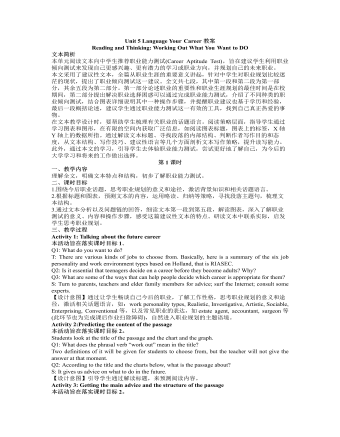
新人教版高中英语选修4Unit 5 Language Your Career教案
本单元阅读文本向中学生推荐职业能力测试(Career Aptitude Test),旨在建议学生利用职业倾向测试来发现自己更感兴趣、更有潜力的学习或职业方向,并规划自己的未来职业。 本文采用了建议性文本,全篇从职业生涯的重要意义讲起,针对中学生对职业规划比较迷茫的现状,提出了职业倾向测试这一建议。全文共七段,其中第一段和第二段为第一部分,其余五段为第二部分。第一部分论述职业的重要性和职业生涯规划的最佳时间是在校期间,第二部分提出解决职业选择困惑可以通过完成职业能力测试,介绍了不同种类的职业倾向测试,结合图表详细说明其中一种操作步骤,并提醒职业建议也基于学历和经验,最后一段概括论述,建议学生通过职业能力测试这一有效的工具,找到自己真正热爱的事物。 在文本教学设计时,要帮助学生梳理有关职业的话题语言。阅读策略层面,指导学生通过学习图表和图形,在有限的空间内获取广泛信息,如阅读图表标题,图表上的标签,X轴Y轴上的数据所指。
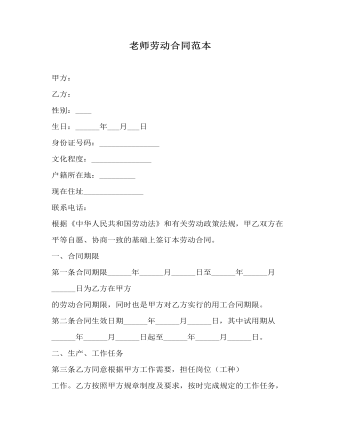
英语老师劳动合同
九、社会保险和福利第十九条甲、乙方协商社保由员工自己办理,甲方每月将社保金直接发放给乙方;第二十条甲方应当创造条件,改善集体福利,提高乙方的福利待遇。十、合同的终止和解除第二十一条双方订立的劳动用工合同期限届满,本合同将自动解除、终止。第二十二条乙方有下列情形之一的,甲方可以解除本合同:(一)严重违反了劳动纪律或者甲方规章制度。(二)严重失职,营私舞弊,对甲方利益造成了重大损害。(三)泄露甲方信息机密和技术机密资料,造成了甲方重大损失。(四)因自身原因被劳动教育以及被依法追究刑事责任。(五)不能胜任工作,经过培训或调整工作岗位后,仍不能胜任。(六)患病或因非工伤,医疗期满后,不能从事原工作也不能从事由甲方另行安排的工作。
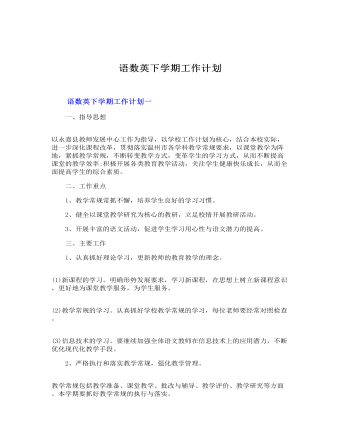
语数英下学期工作计划
二、工作重点 1、教学常规常抓不懈,培养学生良好的学习习惯。 2、健全以课堂教学研究为核心的教研,立足校情开展教研活动。 3、开展丰富的语文活动,促进学生学习用心性与语文潜力的提高。
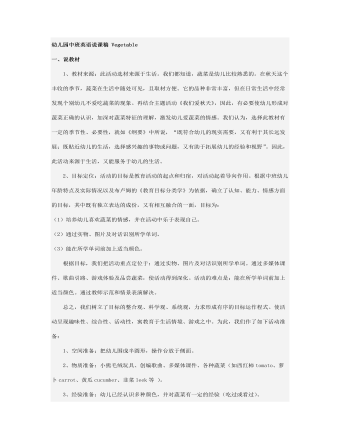
幼儿园中班英语说课稿 Vegetable
教材来源:此活动选材来源于生活。我们都知道,蔬菜是幼儿比较熟悉的。在秋天这个丰收的季节,蔬菜在生活中随处可见,且取材方便。它的品种非常丰富,但在日常生活中经常发现个别幼儿不爱吃蔬菜的现象。再结合主题活动《我们爱秋天》,因此,有必要使幼儿形成对蔬菜正确的认识,加深对蔬菜特征的理解,激发幼儿爱蔬菜的情感。我们认为,选择此教材有一定的季节性、必要性,就如《纲要》中所说,“既符合幼儿的现实需要,又有利于其长远发展;既贴近幼儿的生活,选择感兴趣的事物或问题,又有助于拓展幼儿的经验和视野”。因此,此活动来源于生活,又能服务于幼儿的生活。
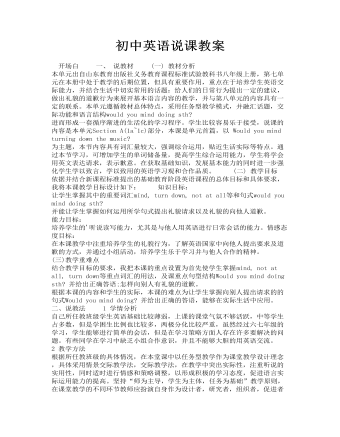
初中英语说课教案
(二) 教学目标 依据并结合新课程标准提出的基础教育阶段英语课程的总体目标和具体要求,我将本课教学目标设计如下: 知识目标: 让学生掌握其中的重要词汇mind, turn down, not at all等和句式would you mind doing sth? 并能让学生掌握如何运用所学句式提出礼貌请求以及礼貌的向他人道歉。
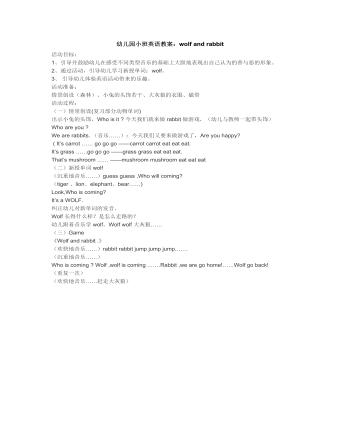
幼儿园小班英语教案:wolf and rabbit
2、通过活动,引导幼儿学习新授单词:wolf。 3、 引导幼儿体验英语活动带来的乐趣。 活动准备: 情景创设(森林)、小兔的头饰若干、大灰狼的衣服、磁带 活动过程: (一)情景创设(复习部分动物单词) 出示小兔的头饰,Who is it ? 今天我们就来做rabbit做游戏,(幼儿与教师一起带头饰) Who are you ? We are rabbits. (音乐……):今天我们又要来做游戏了,Are you happy? ( It’s carrot …… go go go ——carrot carrot eat eat eat.It’s grass ……go go go ——grass grass eat eat eat.That’s mushroom …… ——mushroom mushroom eat eat eat(
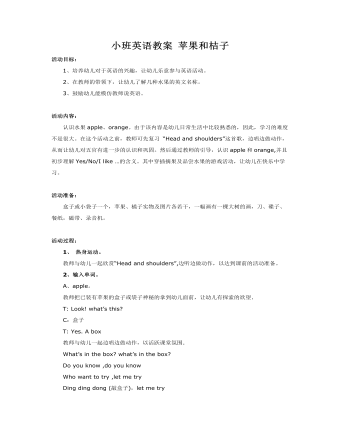
小班英语教案 苹果和桔子
2、在教师的带领下,让幼儿了解几种水果的英文名称。3、鼓励幼儿能模仿教师说英语。 活动内容: 认识水果apple、orange。由于该内容是幼儿日常生活中比较熟悉的,因此,学习的难度不是很大。在这个活动之前,教师可先复习 “Head andshoulders”这首歌,边唱边做动作,从而让幼儿对五官有进一步的认识和巩固。然后通过教师的引导,认识apple和orange,并且初步理解Yes/No/I like …的含义。其中穿插摘果及品尝水果的游戏活动,让幼儿在快乐中学习。 活动准备: 盒子或小袋子一个,苹果、橘子实物及图片各若干,一幅画有一棵大树的画,刀、碟子、餐纸,磁带、录音机。活动过程:1、热身运动。 教师与幼儿一起欣赏“Head andshoulders”,边听边做动作,以达到课前的活动准备。
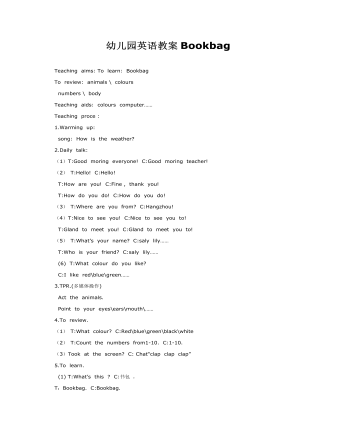
幼儿园英语教案Bookbag
Teaching aids: colours computer…… Teaching proce : 1.Warming up: song: How is the weather? 2.Daily talk: (1)T:Good moring everyone! C:Good moring teacher! (2) T:Hello! C:Hello! T:How are you! C:Fine , thank you! T:How do you do! C:How do you do! (3) T:Where are you from? C:Hangzhou! (4)T:Nice to see you! C:Nice to see you to! T:Gland to meet you! C:Gland to meet you to! (5) T:What’s your name? C:saly lily…… T:Who is your friend? C:saly lily…… (6) T:What colour do you like? C:I like red\blue\green……
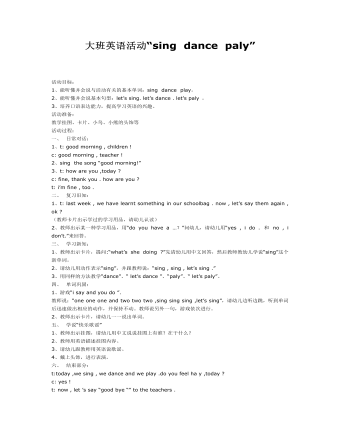
大班英语教案:“sing dance paly”
2、能听懂并会说基本句型:let’s sing. let’s dance .let’s paly 。 3、培养口语表达能力,提高学习英语的兴趣。 活动准备: 教学挂图、卡片、小鸟、小熊的头饰等 活动过程: 一、 日常对话: 1、t: good morning , children! c: good morning , teacher ! 2、sing the song “goodmorning!” 3、t: how are you ,today? c: fine, thank you . how are you ? t: i’m fine , too . 二、 复习旧知: 1、t: last week , we havelearnt something in our schoolbag . now , let’s say them again , ok ? (教师卡片出示学过的学习用品,请幼儿认读) 2、教师出示某一种学习用品,用“do you have a …?”问幼儿,请幼儿用“yes , i do . 和 no , i don’t.”来回答。
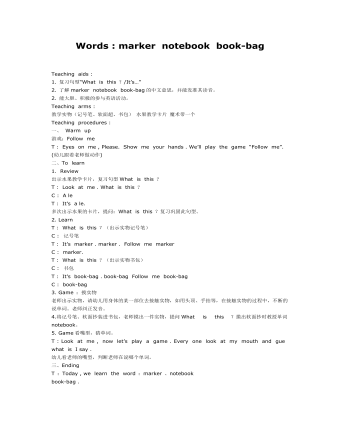
大班英语教案:Words marker notebook book-bag
2. 了解marker notebook book-bag的中文意思,并能发准其读音。 2. 能大胆、积极的参与英语活动。 Teaching arms : 教学实物(记号笔、软面超、书包)水果教学卡片魔术带一个 Teaching procedures : 一、 Warm up 游戏:Follow me T : Eyes on me , Please. Show me your hands . We’ll play the game “Follow me”. (幼儿跟着老师做动作) 二、To learn 1. Review 出示水果教学卡片,复习句型What is this ? T : Look at me . What is this ? C : A le T : It’s a le. 多次出示水果的卡片,提问:What is this ?复习巩固此句型。
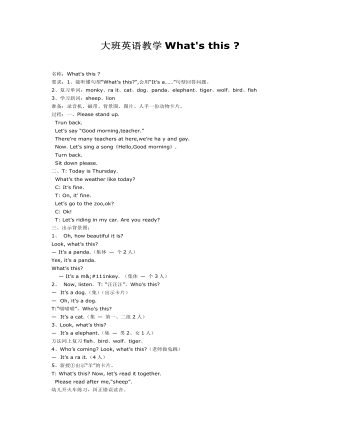
大班英语教案:What's this
要求:1、能听懂句型“What’s this?”,会用“It’s a……”句型回答问题。 2、复习单词:monky、ra it、cat、dog、panda、elephant、tiger、wolf、bird、fish 3、学习新词:sheep、lion 准备:录音机、磁带、背景图、图片、人手一份动物卡片。 过程:一、Please stand up. Trun back. Let’s say “Good morning,teacher.” There’re many teachers at here,we’re ha yand gay. Now. Let’s sing a song《Hello,Good morning》. Turn back. Sit down please. 二、T: Today is Thursday. What’s the weather like today? C: It’s fine. T: On, it’ fine. Let’s go to the zoo,ok? C: Ok! T: Let’s riding in my car. Are youready?
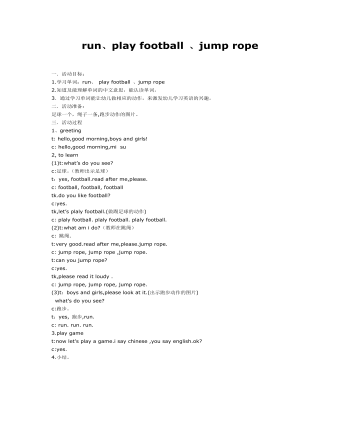
大班英语教案:run、play football 、jump rope
二.活动准备: 足球一个,绳子一条,跑步动作的图片。 三.活动过程 1、greeting t: hello,good morning,boys and girls! c: hello,good morning,mi su 2, to learn (1)t:what’s do you see? c:足球。(教师出示足球) t:yes, football.read afterme,please. c: football, football, football tk.do you like football? c:yes. tk,let’s plaly football.(做踢足球的动作) c: plaly football. plaly football. plaly football.
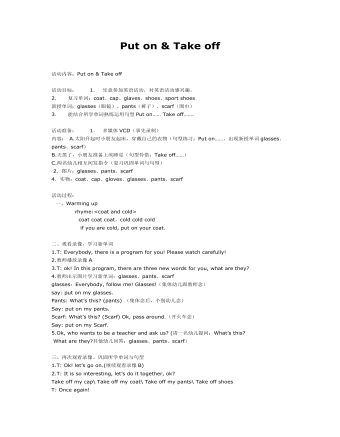
大班英语教案:Put on & Take off
2. 复习单词:coat、cap、glaves、shoes、sportshoes新授单词:glasses(眼镜)、pants(裤子)、scarf(围巾)3. 能结合所学单词熟练运用句型Put on…… Take off……. 活动准备: 1. 多媒体VCD(事先录制)内容: A.太阳升起时小朋友起床,穿戴自己的衣物(句型练习:Put on……、出现新授单词glasses、pants、scarf)B.天黑了,小朋友准备上床睡觉(句型怜惜:Take off……)C.两名幼儿相互间发指令(复习巩固单词与句型)
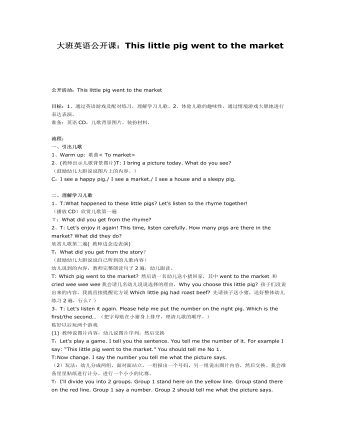
大班英语教案:This little pig went to the market
流程: 一、引出儿歌 1、Warm up: 歌曲< To market> 2、(教师出示儿歌背景图片)T: I bring a picturetoday. What do you see? (鼓励幼儿大胆说说图片上的内容。) C:I see a happy pig./ I see a market./ Isee a house and a sleepy pig. 二、理解学习儿歌 1、T:What happened to these little pigs?Let’s listen to the rhyme together! (播放CD)欣赏儿歌第一遍 T:What did you get from the rhyme?
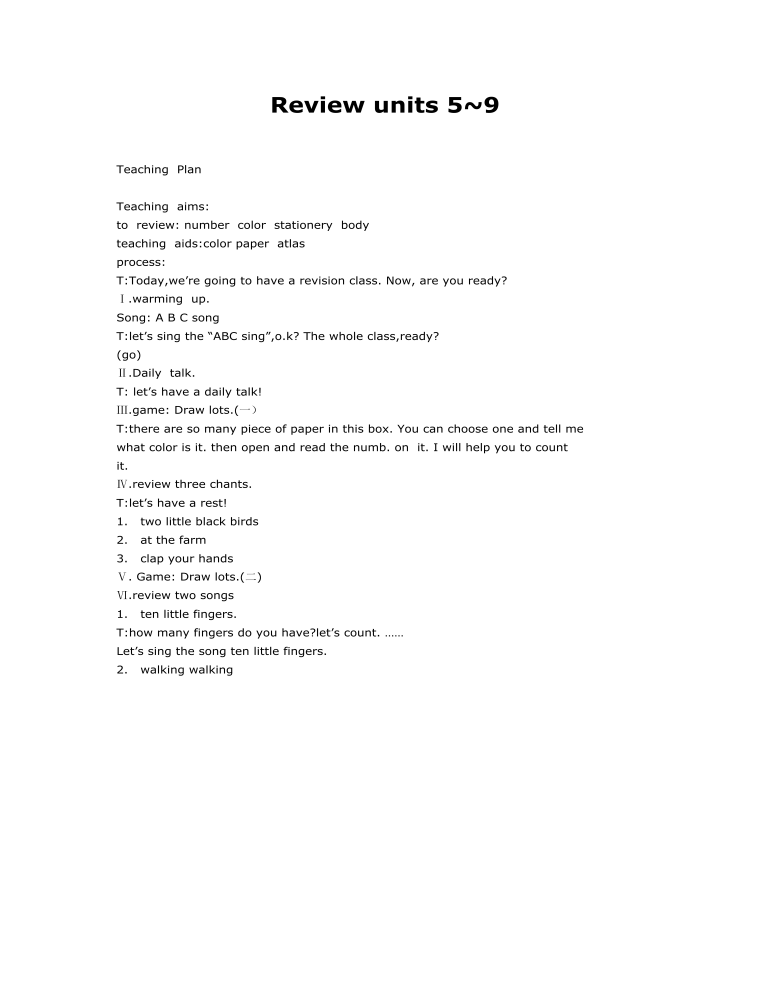
大班英语教案:Review units 5~9
T:Today,we’re going to have a revision class. Now, are you ready?Ⅰ.warming up.Song: A B C songT:let’s sing the “ABC sing”,o.k? The wholeclass,ready?(go)Ⅱ.Daily talk.T: let’s have a daily talk!Ⅲ.game:Draw lots.(一)T:there are so many piece of paper in this box.You can choose one and tell me what color is it. then open and read the numb.on it. I will help you to count it.
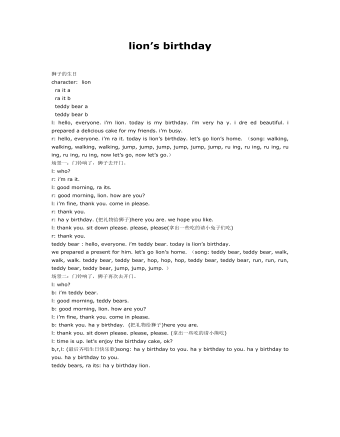
大班英语教案:lion’s birthday
场景一:门铃响了,狮子去开门。 l: who? r: i’m ra it. l: good morning, ra its. r: good morning, lion. how are you? l: i’m fine, thank you. come in please. r: thank you. r: ha y birthday. (把礼物给狮子)here you are. we hope youlike. l: thank you. sit down please. please, please(拿出一些吃的请小兔子们吃) r: thank you. teddy bear : hello, everyone. i’m teddy bear.today is lion’s birthday. we prepared a present for him. let’s go lion’shome. (song: teddy bear, teddy bear, walk, walk, walk. teddy bear,teddy bear, hop, hop, hop, teddy bear, teddy bear, run, run, run, teddy bear,teddy bear, jump, jump, jump. )

